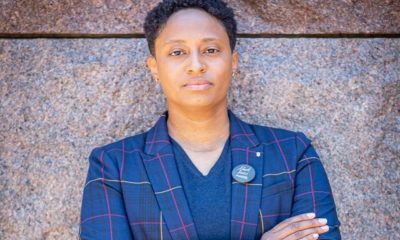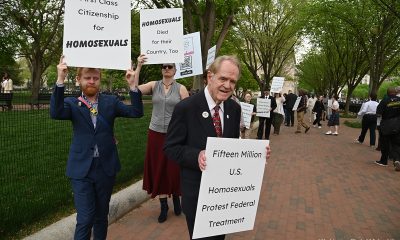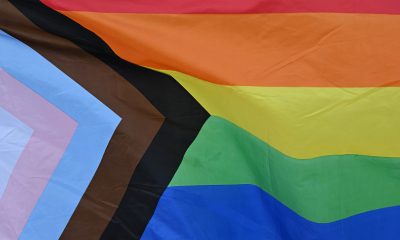National
SPECIAL REPORT: Poverty in the LGBT community
Studies show image of ‘gay affluence’ is a myth
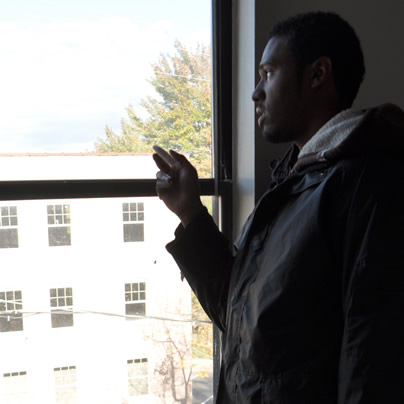
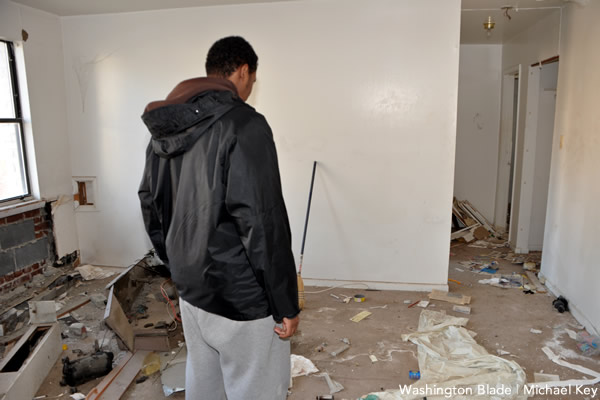
Kadeem Swenson told the Blade in 2010 that his parents kicked him out of the house for being gay. He spent a year living in abandoned buildings in D.C. (Washington Blade photo by Michael Key)
Editor’s note: This week, the Blade kicks off a special yearlong focus on poverty in the LGBT community. The occasional series will examine the problem with special reports from D.C. and around the country. To share your ideas or personal story, visit us on Facebook or email [email protected].
As the 50th anniversary of the U.S. war on poverty launched by President Lyndon B. Johnson in 1964 is commemorated this year, LGBT advocates are pointing to little noticed studies showing that the rate of poverty in the LGBT community is higher than that of the general population.
In a 2013 report analyzing data from the U.S. Census Bureau and other data measuring poverty in the United States, the Williams Institute, a research arm at the University of California Law School in Los Angeles that specializes in LGBT issues, concludes that rates of poverty are higher than the general population among gay men and lesbians between the ages of 18-44 and gay men and lesbians living alone.
The report shows that couples – both gay and straight – tend to have a lower rate of poverty than single people and the population as a whole. But it found that the poverty rate for lesbian couples is higher than that of gay male couples and opposite-sex couples and the poverty rate of same-sex African-American couples is higher than it is for opposite-sex African-American couples.
Among the report’s findings that surprised LGBT activists were data showing that bisexual men and women had poverty rates of 25.9 percent and 29.4 percent respectively – higher than gay men (20.5 percent) and lesbians (22.7 percent). The report says the same set of data show that heterosexual men had a poverty rate of 15.3 percent compared to a rate of 21.1 percent for heterosexual women.
“The LGB poverty data help to debunk the persistent stereotype of the affluent gay man or lesbian,” the Williams Institute report says.
“Instead, the poverty data are consistent with the view that LGB people continue to face economic challenges that affect their income and life chances, such as susceptibility to employment discrimination, higher rates of being uninsured, and a lack of access to various tax and other financial benefits via exclusion from the right to marry,” the report says.
The report uses the U.S. Census Bureau definition of poverty for 2012 in its analysis of LGBT poverty levels based on family income. That definition lists the “poverty line” for a single person household as an annual income of $11,815 or less. The poverty line for a two-person household was $15,079, and for a four-person household was $23,684 in 2012.
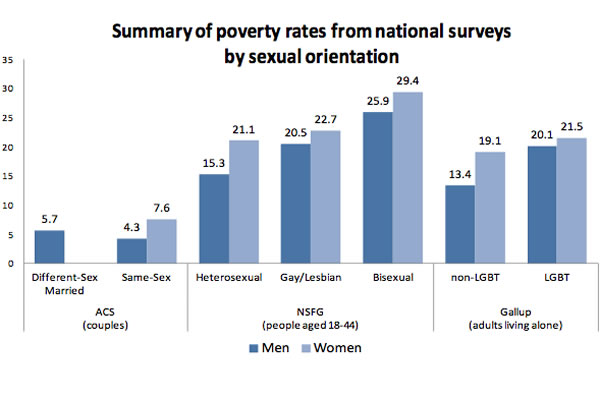
Researchers with the Williams Institute say this graph summarizes their findings of higher poverty rates among samples of mostly LGB and some LGBT people in the U.S. The bar graph on the left represents data taken from the U.S. Census Bureau’s 2010 American Community Survey (ACS). The chart in the center is taken from data from the U.S. Center for Disease Control and Prevention’s 2010 National Survey of Family Growth (NSFG). The chart at right is from a 2012 phone survey conducted by the Gallup Poll organization. (Graph courtesy of the Williams Institute)
Trans poverty ‘extraordinarily high’
A separate study prepared jointly by the National Center for Transgender Equality and the National Gay and Lesbian Task Force in 2011, called “Injustice at Every Turn,” shows dramatically higher rates of poverty and homelessness among transgender Americans in each state, the District of Columbia and U.S. territories.
Kylar Broadus, senior policy counsel and director of the Trans Civil Rights Project for The Task Force, called the poverty rate in the transgender community “extraordinarily high.” He said a key factor leading to economic hardship among transgender people is the persistent problem of employment discrimination.
“There’s double the national rate of unemployment,” he said in discussing the trans community of which he said he’s a member. “And once we’re employed 90 percent of those surveyed reported experiencing harassment and discrimination on the job,” he noted in pointing to the NCTE-Task Force study.
“Forty-seven percent said they experienced adverse outcomes such as being fired, not hired or denied promotions because of being transgender or gender non-conforming,” Broadus said.
He said the respondents reported various forms of housing discrimination that are contributing factors to homelessness in the transgender community. According to the study, 19 percent of respondents reported having been refused a home or an apartment to rent and 11 percent reported being evicted because of their gender identity or expression.
“Nineteen percent experienced homelessness at some point in their lives because they were transgender or didn’t conform as well, and then 55 percent were denied access to shelters,” he said.
Another study released by the Williams Institute last week reports that 2.4 million LGBT adults, or 29 percent, “experienced a time in the last year when they did not have enough money to feed themselves or their family.”
The study, written by Williams Institute demographer Gary Gates, found that LGBT people are more likely to rely on the federal food stamp program for assistance than their heterosexual counterparts.
“One in four bisexuals (25 percent) receive food stamps,” the report says, “34 percent of LGBT women were food insecure in the last year; and LGBT African Americans, Native Americans, and Native Hawaiians experienced food insecurity in the last year at rates of 37 percent, 55 percent, and 78 percent respectively,” the report says.
LGBT homeless rate high in San Fran
Yet another report released last June found that 29 percent of the homeless population in San Francisco identified as LGBT. The report, which was part of the city’s biennial homeless count, included for the first time a count of the number of homeless people who identified themselves as gay, lesbian, bisexual or transgender, according to the San Francisco Chronicle.
Brian Bassinger, director of the San Francisco-based AIDS Housing Alliance, which provides services to the HIV and LGBT communities, said although the finding to some degree reflects the high LGBT population in San Francisco, which is 15 percent, he believes LGBT people make up a sizable percent of the homeless population in other cities throughout the country.
Bassinger said he also believes the 29 percent figure for San Francisco is most likely an under count and that the actual number is higher.
“LGBT people in the shelter system here are regularly targeted for violence, harassment and hate crimes, which are very well documented,” he said.
Since much of the effort to count homeless people in the city takes place at shelters, large numbers of LGBT homeless people are not counted because they generally avoid the shelters out of fear of harassment and violence, Bassinger said.
He said his group also closely monitors a development in San Francisco threatening to push the city’s older LGBT population into poverty and which may be occurring in other cities – the enormous rise in the cost of housing due to gentrification and a booming real estate market. Those who for years have lived in popular gay neighborhoods as tenants are being displaced by the conversion of rental apartment buildings and houses into upscale condominiums, Bassinger said.
“Long-term San Franciscans who have spent decades building the system to deliver access to equal treatment under the law here in San Francisco are getting displaced by all of these people moving into our community,” he said.
And because they can no longer afford to live in San Francisco many are being forced to move to other parts of the state or other states that are less LGBT friendly and don’t have the support community they came to enjoy for so many years, according to Bassinger.
The Williams Institute’s 2013 report, meanwhile, analyzes data from four surveys of the U.S. population with a demographic breakdown that included mostly gay men, lesbians, and bisexuals as well as a smaller, combined “LGBT” sample.
The four surveys were conducted by these organizations or government agencies:
• The 2010 American Community Survey conducted by the U.S. Census Bureau with a sample of more than 500,000 and which included data from same-sex couple households.
• The National Survey of Family Growth conducted by the U.S. Centers for Disease Control and Prevention’s National Center for Health Statistics from 2006-2010 included a sample of more than 19,000 people throughout the country, including people who identified as LGB, the Williams Institute study says.
• The California Health Interview Survey conducted by UCLA’s Center for Health Policy Research in collaboration with California Department of Public Health surveyed more than 50,000 Californians, including LGB adults from 2007 to 2009.
• A Gallup Daily Tracking Poll conducted between June 1 and Sept. 30, 2012 with a sample of more than 120,000 adults from 18 and older, included people who identified themselves as LGBT in all 50 states and D.C. The poll was conducted by phone.
The report includes these additional findings on the subject of poverty in the LGBT community:
• African-American same-sex couples have poverty rates more than twice the rate of different-sex married African Americans.
• One-third of lesbian couples and 20.1 percent of gay male couples who don’t have a high school diploma are in poverty, compared to 18.8 percent of heterosexual couples.
• Lesbian couples living in rural areas are more likely to be poor (14.1 percent) compared to 4.5 percent of lesbian couples in large cities; 10.2 percent of gay male couples who live in small metropolitan areas are poor compared with just 3.3 percent of gay male couples who live in large metropolitan areas.
• Nearly one in four children living with a male same-sex couple and 19.2 percent of children living with a female same-sex couple is in poverty. This compares with 12.1 percent of children living with married heterosexual couples who are in poverty.
• African-American children in gay male households have the highest poverty rate (52.3 percent) of any children in any household type.
• 14 percent of lesbian couples and 7.7 percent of gay male couples received food stamps, compared to 6.5 percent of straight married couples. In addition, 2.2 percent of same-sex female couples received government cash assistance compared to 0.8 percent of women in different-sex couples. And 1.2 percent of men in same-sex couples received cash assistance compared to 0.6 percent of men in different-sex couple relationships who received cash assistance.
The report’s co-author Lee Badgett, a Williams Institute senior fellow and professor at the University of Massachusetts at Amherst, said it’s difficult to draw a conclusion from the Williams Institute and other studies as to why there are higher poverty levels in the LGBT community.
“The people that I know who worked with LGBT people in poverty talk about the reasons being very complex,” she said.
“I suspect that there are lots of disadvantages that people face, whether it’s in the labor market or in schools and that maybe somehow they kind of come together, that they are sort of cumulative over time and make people more vulnerable to poverty. But I think we don’t really know exactly why that happens,” Badgett told the Blade.
In the Williams Institute report, she and co-authors Laura Durso and Alyssa Schneebaum call for further studies to explore the factors that contribute both to “poverty and economic resilience” within the LGBT community.
“Our analyses highlight different demographic subpopulations that may be particularly at-risk; however, we are unable to take a more fine-grained approach to identifying factors that contribute to poverty in these different communities,” the report says.
“Identifying the conditions under which individuals and families descend into and escape from poverty will aid service organizations and government agencies in designing interventions to address this significant social problem,” the report concludes.
Broadus of the Task Force said discrimination and bias make up at least some of the conditions that force LGBT people into poverty.
“We are less economically secure as a community due to suffering at the hands of discrimination in employment, marriage, insurance and less familial and societal support,” he said. “The LGBT community as a whole lives at the margins and some at the margins of the margins such as women, people of color and children. When some of our community is vulnerable we are all vulnerable.”
National
National resources for trans and gender diverse communities
Amid attacks, help is available from wide range of organizations

The Trump administration has launched a series of executive orders and other initiatives restricting the rights of the transgender community since taking power in January, targeting military service, affirming healthcare, and participation in sports.
Though many executive orders are being challenged in court, it’s an uncertain time for a community that feels threatened. Despite the uncertainty, there are resources out there to help.
From legal assistance to mental health support, here’s a list of nonprofits and organizations dedicated to improving the everyday livelihood of trans and gender diverse people. These are mostly national organizations; there are many additional groups that work in local communities across the country. Some of these national groups will connect those in need of help to a local organization.
LEGAL HELP
President Trump issued an executive order declaring there are only two genders –– male and female –– which applies to legal documents and passports. The order doesn’t recognize the idea that one can transition their gender at birth to another gender.
Ash Lazarus Orr filed to renew his passport with a gender marker reflecting his identity. That was in January, and he still hasn’t received it. He refused to accept a passport without an accurate identification of who he is, so he filed a lawsuit with the ACLU in what is now known as Orr v. Trump.
Orr told the Washington Blade that not receiving his passport back has taken away his freedom of visiting family in Canada and receiving gender-affirming care from a trusted provider in Ireland.
The one thing getting him through this uncertain time is knowing who he’s fighting for –– the trans community, his loved ones, and himself.
“I’m trying to be that person that those younger parts of me needed growing up,” Orr said. Check out a couple of legal support organizations below:
Transgender Law Center
The Transgender Law Center (TLC) provides legal resources and assistance. TLC has a list –– called the Attorney Solidarity Network –– of attorneys that can provide advice or representation for trans people.
The organization also has a legal information help desk that answers questions regarding laws or policies impacting trans people.
Website: transgenderlawcenter.org
Phone: 510-587-9696
Email: [email protected]
Advocates For Trans Equality
With a variety of different programs tailored toward legal assistance and advocacy work, Advocates For Trans Equality’s reach is wide.
The non-profit offers the Name Change Project, which provides pro bono legal name change services to low-income trans, gender-non-conforming and nonbinary people by utilizing its partnerships with law firms and corporate law departments.
Advocates For Trans Equality also has departments and programs dedicated to increasing voter engagement, educating lawmakers on trans issues and offering litigation assistance to a small number of cases.
Website: transequality.org
Phone: 202-642-4542
General email: [email protected]
To contact a specific department or program, visit its website above.
ADVOCACY
Looking to take action and get involved? Act now.
American Civil Liberties Union
The ACLU is a national nonprofit organization that mobilizes local communities and advocates for national causes.
Getting involved is as easy as filling out letters to representatives or signing petitions. One live petition is to “defend trans freedom.”
You can also join its People Power platform, where you serve as a volunteer in your community to “advance civil liberties and civil rights for all.” ACLU has different chapters across the country, so visit its website for more information.
Website: aclu.org
Phone: 212-549-2500
MILITARY AND VETERANS
Trump signed an executive order in January banning transgender service members from serving, stating their identity “conflicts with a soldier’s commitment to an honorable, truthful and disciplined lifestyle, even in one’s personal life.”
Though the order has been legally challenged and struck down by a judge, U.S. Navy Lieutenant Rae Timberlake said it’s created an uncertain atmosphere for themself and other troops.
“All of the transgender service members I know have served with honor and integrity for many years…[and we’re] targeted for removal and not subject to any kind of review based on merit,” Timberlake, who joined the Navy at age 17, said. “There’s kind of just this cloud looming over our organizations and our units, because we know any day our transgender shipmates could no longer be on the team.”
But Timberlake’s message to any service member struggling because of the executive order was one of compassion and truth: “There’s no policy that can take away what you’ve accomplished and what you’ve done.”
Here are some organizations that support service members and veterans:
SPARTA Pride
SPARTA is a peer-support group composed of active duty, veteran and “future warrior” service members.
The group also engages in advocacy work and has helped change policies on gender neutral uniforms and reducing the time a trans service member would have to wait to return to their duties during their transition.
Contact SPARTA to learn more about joining its support network.
Website: spartapride.org
Email: [email protected]
Modern Military Association
Modern Military supports service members and veterans through advocacy, legal assistance and mental health support.
It tracks LGBTQ+ and HIV discrimination through reports made on its website, and offers guidance and advice to whoever submitted the report.
It also supports the mental health of LGBTQ+ veterans and their families through its Resilient Heroes Program. By signing up, you’ll receive virtual peer support and case management services with a mental health coordinator.
Website: modernmilitary.org
Phone: 202-328-3244
Email: [email protected]
CRISIS & MENTAL HEALTH SUPPORT
If you have a more urgent matter, or just need someone to listen, here are some organizations you can reach out to:
The Trevor Project
The Trevor Project offers 24/7 counseling services. Calling, texting or chatting is free and confidential, and you’ll get to speak with someone specialized in supporting LGBTQ youth.
The organization also focuses on public education by hosting online LGBTQ suicide prevention trainings. It advocates for policies and laws that contribute to supporting queer youth.
Website: thetrevorproject.org
Crisis hotline: 1-866-488-7386
General inquiry phone number: 212-695-8650
Trans Lifeline
Trans Lifeline is a hotline run and operated by trans people. Whether you’re questioning if you’re trans or are a trans person just wanting to talk, someone will be there to help. It’s free and confidential, and there won’t be any non-consensual active rescue, such as calling the emergency services.
The line is not 24/7, however. Check out its website for hours within your time zone.
Website: translifeline.org
Phone: 877-565-8860
Here are other organizations that offer support to the trans community:
TransFamilies (support): Support for families with a gender diverse child.
TransLatina Coalition (advocacy): Advocates for the specific needs of the transgender, gender expansive and intersex communities in the U.S.
TransAthlete (information): Provides informative resources about trans athletes.
Campaign for Southern Equality’s Trans Youth Emergency Project (healthcare support): A fund to help trans youth access lifesaving healthcare.
TransTech Social (economic empowerment): Dedicated to discovering and empowering the career-ready skills of LGBTQ+ people.
World Professional Association For Transgender Health (health): Resources, symposiums and research dedicated to improving transgender health.
Sylvia Rivera Law Project (legal): Legal programs and services for marginalized communities.
Gender Spectrum (support): Resources and support groups for trans youth and families.
The Okra Project (support): Creates and supports initiatives that provide resources for the Black Trans community.
The White House
White House does not ‘respond’ to reporters’ requests with pronouns included
Government workers were ordered not to self-identify their gender in emails
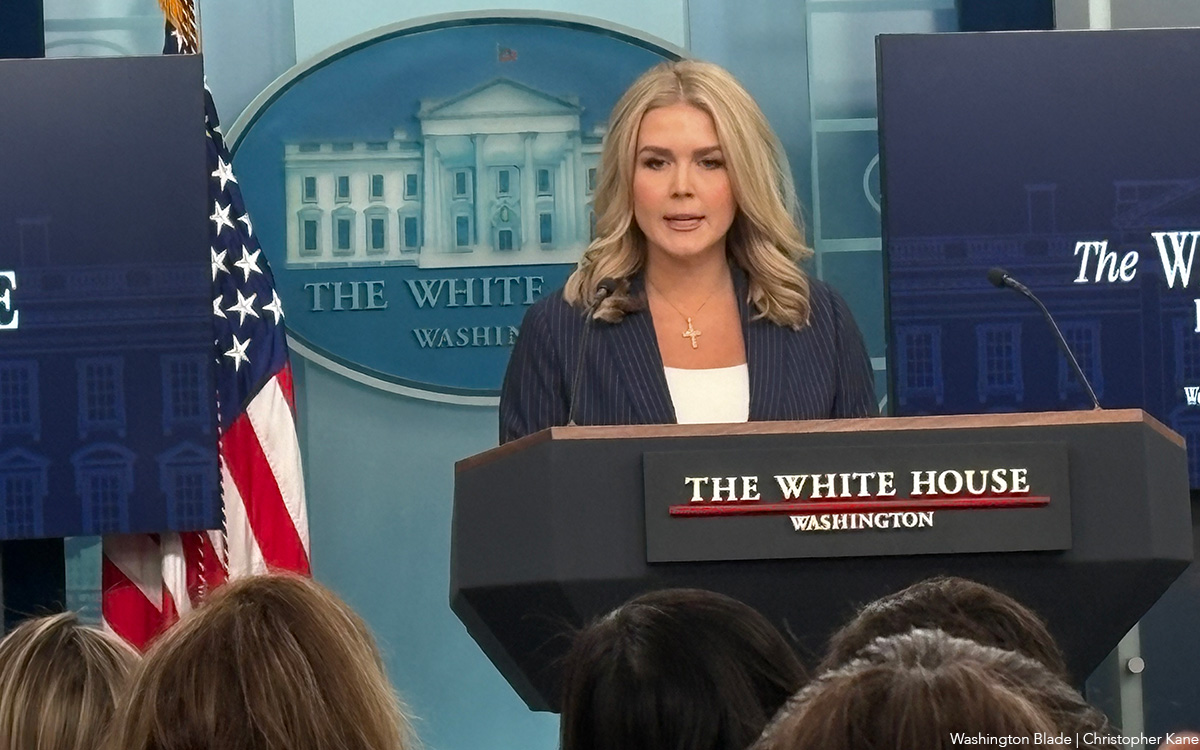
White House Press Secretary Karoline Leavitt and a senior advisor in the Department of Government Efficiency rejected requests from reporters who included their pronouns in the signature box of their emails, each telling different reporters at the New York Times that “as a matter of policy,” the Trump-Vance administration will decline to engage with members of the press on these grounds.
News of the correspondence between the journalists and the two senior officials was reported Tuesday by the Times, which also specified that when reached for comment, the White House declined to “directly say if their responses to the journalists represented a new formal policy of the White House press office, or when the practice had started.”
“Any reporter who chooses to put their preferred pronouns in their bio clearly does not care about biological reality or truth and therefore cannot be trusted to write an honest story,” Leavitt told the Times.
Department of Government Efficiency Senior Advisor Katie Miller responded, “I don’t respond to people who use pronouns in their signatures as it shows they ignore scientific realities and therefore ignore facts.”
Steven Cheung, the White House communications director, wrote in an email to the paper: “If The New York Times spent the same amount of time actually reporting the truth as they do being obsessed with pronouns, maybe they would be a half-decent publication.”
A reporter from Crooked media who got an email similar to those received by the Times reporters said, “I find it baffling that they care more about pronouns than giving journalists accurate information, but here we are.”
The practice of adding pronouns to asocial media bios or the signature box of outgoing emails has been a major sticking point for President Donald Trump’s second administration since Inauguration Day.
On day one, the White House issued an executive order stipulating that the federal government recognizes gender as a binary that is immutably linked to one’s birth sex, a definition excludes the existence of intersex and transgender individuals, notwithstanding the biological realities that natal sex characteristics do not always cleave neatly into male or female, nor do they always align with one’s gender identity .
On these grounds, the president issued another order that included a directive to the entire federal government workforce through the Office of Personnel Management: No pronouns in their emails.
As it became more commonplace in recent years to see emails with “she/her” or “he/him” next to the sender’s name, title, and organization, conservatives politicians and media figures often decried the trend as an effort to shoehorn woke ideas about gender (ideas they believe to be unscientific), or a workplace accommodation made only for the benefit of transgender people, or virtue-signaling on behalf of the LGBTQ left.
There are, however, any number of alternative explanations for why the practice caught on. For example, a cisgender woman may have a gender neutral name like Jordan and want to include “she/her” to avoid confusion.
A spokesman for the Times said: “Evading tough questions certainly runs counter to transparent engagement with free and independent press reporting. But refusing to answer a straightforward request to explain the administration’s policies because of the formatting of an email signature is both a concerning and baffling choice, especially from the highest press office in the U.S. government.”
U.S. Military/Pentagon
Air Force rescinds rule barring inclusion of preferred pronouns in email signatures
Conflict with language in military funding package may explain reversal

The U.S. Air Force has issued a “directive to cease the use of ‘preferred pronouns’ (he/him, she/her, or they/them) to identify one’s gender identity in professional communications,” according to a report published in the Hill on Wednesday.
The rule, which applies to both airmen and civilian employees, was first adopted on Feb. 4 pursuant to President Donald Trump’s anti-transgender executive order called, “Defending Women from Gender Ideology Extremism and Restoring Biological Truth to the Federal Government.”
Days after the administration’s issuance of that order on the first day of the president’s second term, the Office of Personnel Management instructed agencies across the whole of the federal government to remove pronouns from email signatures and enforce the policy barring employees from using them.
Additionally, on Jan. 27 Trump published an order barring trans people from joining the U.S. Armed Forces, indicating that those who are currently in serving would be separated from the military. The Pentagon is fending off legal challenges to the ban in federal courts.
Particularly given the extent of the new administration’s efforts to restrict the rights of trans Americans and push them out of public life, the Air Force’s reversal of the pronoun guidance was surprising.
According to reporting in Military.com, the move might have come because officials concluded the rule was in conflict with language in the military appropriations funding legislation passed by Congress in 2023.
The NDAA established that the defense secretary “may not require or prohibit a member of the armed forces or a civilian employee of the Department of Defense to identify the gender or personal pronouns of such member or employee in any official correspondence of the Department.”
-
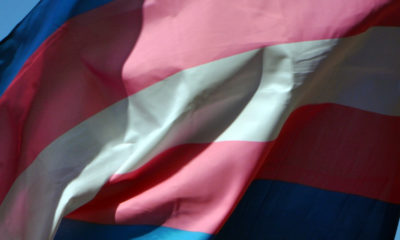
 Opinions5 days ago
Opinions5 days agoIt’s time for new leadership on the Maryland LGBTQIA+ Commission
-

 The White House5 days ago
The White House5 days agoWhite House does not ‘respond’ to reporters’ requests with pronouns included
-
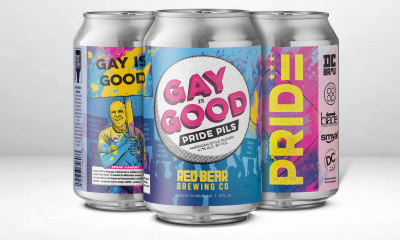
 Arts & Entertainment5 days ago
Arts & Entertainment5 days ago‘Gay is Good’ Pride Pils Can Celebrates Frank Kameny’s 100th Birthday for WorldPride in D.C.
-

 Sponsored5 days ago
Sponsored5 days agoTHC Drinks: What You Should Know About Cannabis Beverages

